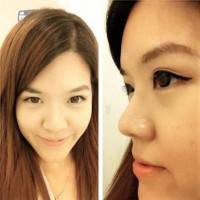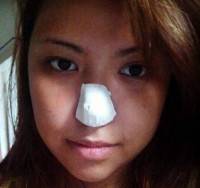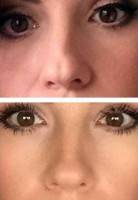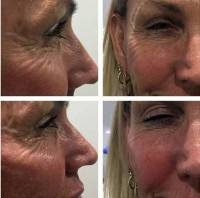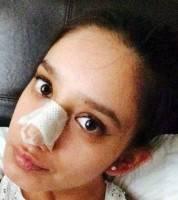What Are Nose Fillers?
Non-surgery nose job is not exactly what it sounds. It is not a temporary nose job which will give you the results of the permanent nose job for three or four months. It is a procedure that can be really helpful to some patients.
It can be used to correct the appearance of the hump, to increase the nasal bridge height, or increase the tip projection. In general non-surgery nose job is the procedure of addition. We add filler, and change proportions, and it may make your nose appear might better.
On the other hand, in general rhinoplasty operation is the procedure of subtraction. It is frequently done to make the nose smaller, narrower or more defined. There are instances when we do surgery to make the nose bigger, but they are less common.
So, to address your question, non-surgery nose job might be a good temporary solution for you, or it might not be. Discuss it with experienced rhinoplasty providers. (Stella Desyatnikova, MD, Seattle Facial Plastic Surgeon)
A nonsurgical nose job is not a rhinoplasty
By definition, a rhinoplasty is a permanent alteration to the nasal structures which changes the appearance of a nose. Fillers can be injected to create a temporary effect by hiding bumps, enlarging a small nose, or filling in a depression.
It will have no positive effects on improving breathing if that is also a desired result. Some fillers that can be used for a nonsurgical augmentation include restylane or juvederm or radiesse. The duration of these fillers can be from 6 months to 18 months if one is lucky.
However, the desired effect is temporary and must be repeated. A large nose that needs to be reduced cannot be treated in this fashion and injectable fillers work best for noses that need augmentation and not reduction. (Scott Trimas, MD, Jacksonville Facial Plastic Surgeon)
A Non-surgery nose job is a simple effective answer for many patients
I have been performing non-surgery nose job procedures for my patients for over 5 years. Initially, I was performing the procedure with only Radiesse but since the introduction of Juvederm and Restylane, I am now able to create beautiful noses tailored to the needs of my patients. A non-surgery procedure is not appropriate for all of my patients but for some of my patients it is the perfect solution and sometimes is the only solution.
Appropriate candidates include:
- Patients who have a shallow nasal bridge that can be built up ( asians )
- Patients with a small nasal humps by building up the nose above and below the hump
- Patients with minor deformities of the tip cartilage
- Patients with minor deformities caused by surgical techniques.
- Patients who refuse surgery
- Patients who can’t afford traditional surgery (Phillip Chang, MD, Leesburg Plastic Surgeon)
Can a non-surgical nose job replace rhinoplasty?
Non-surgery nose job is a precudure where a filler such as Restylane or Radiesse is injected into the nose, to change the contour. There has been significant media coverage of “non-surgery nose job”. However, non-surgery nose job can not replace rhinoplasty for cosmetic improvement of the nose. There are only a few limited indications where non-surgery nose job can be effective. These include:
- Effacement of depressions on the dorsum of the nose.
- Smoothing of the edges in a small dorsal hump.
- Augmenting a retrusive naso-labial angle.
However, non-surgery nose job is not indicated for:
- Making a nose smaller or narrower
- Making a tip more defined or smaller
- De-projecting a nose, or narrowing the nostrils.
More over, non-surgery nose job with filler injections has a temporary effect, and will require repeated treatments every 6 to 12 months.
Each treatment can cost between $700 to $1000.
Although a single treatment is cheaper than a nose job, if the process has to be repeated over six times, a nose job would be increasingly a cheaper alternative.
I suggest you consult a facial plastic surgeon, who is capable of performing either procedure, in order to have a full discussion of risks and benefits of each alternative. (Maurice M. Khosh, MD, New York Facial Plastic Surgeon)
Fillers for a nonsurgery nose job
The many great posts here speak for themselves, so I will not be redundant (just give you my bare bones thoughts).basically, fillers for the nose come in many forms and name brands, they are NOT permanent, they only correct VERY specific anatomical issues and they DO NOT correct breathing problems and they resorb over time and go away (did I already say that?)! Fillers genereally last about a year or so, depending on the type and amount used.
I would recommend you see a Board Certified Plastic Surgeon or a Ear/Nose/Throat Surgeon who performs a significant number of surgical rhinoplasties (nose-jobs) to see if indeed you are a candidate. I have used fillers to correct small irregularities on nose previously operated on by others; however, I have not used fillers to correct issues I think are best corrected with surgery. Be careful of cunning marketing ploys and over inflated result claims. (John Philip Connors III, MD, FACS, Atlanta Plastic Surgeon)
What is a Non-Surgical nose reshaping? As others have described in their answers, a Non-Surgical nose reshaping uses injectable fillers (rather than surgery) to achieve a change in the appearance of the nose.
I have used Collagen fillers, Hyaluronic Acid fillers, and Hydroxy-Appetite fillers in the nose for many years. My early cases were all in patients that had deformities left over from either trauma or earlier rhinoplasty surgery.
In the last few years, I’ve injected many noses “primarily” in patients that have not had nasal trauma or surgery. Here are my thoughts on using Fillers in the Nose:
First, I’d recommend that you go to an accomplished rhinoplasty surgeon for any injection into the nose. I perform the same evaluation for a filler as for a surgery, and I always weigh the possible surgical options against the filler option before choosing a filler.
Second, as always, your surgeon should show you pictures of their own patients that have had similar treatments and explain how these compare to what they anticipate for your results with an injection.
In my practice, a large percentage of rhinoplasties seek to reduce the size of the nose, refine the shape of the nasal tip or narrow the nose or nostrils. These are not possible with fillers. I find fillers to be most useful in the nose for camouflaging small irregularities and in cases where adding filler at the bridge of the nose provides a striking improvement in balancing the nasal shape.
For operated or traumatized tissues, the nose may be scarred below the skin and resist being molded or augmented with filler (and typically this is precisely at the location we most desire to fill).
Hyaluronic Acid fillers (Restylane, Juvederm) are a good first choice, particularly for the lower nose and nasal tip. Their disadvantage is that they will likely dissolve within a year or so.
Hydroxy-Appetite filler (Radiesse) is said to be “semi-permanent.” I generally will not inject around the tip cartilages or skin with Radiesse, and some surgeons have reported significant problems with later surgery when this has been done. (Nick Slenkovich, MD, Denver Plastic Surgeon)
Non surgical nose shaping works well, lasts 12-15 months
For thos clients whom want to shape their nose without surgery, Radiesse, (calcium hydroxyapatite), works very well, and last 12-15 months. a good injector will be able to tell you if your goals can be met with “your anatomy”, and make sure you get someone with experience as this filler cannot be “removed” like a hyaluronic acid filler.
In my experience, the hyaluronic acid fillers are not firm enough to give good “sculpting support”, and they become “boggy”, as these fillers are soft, attract water, and do not stay “defined”. (Debra Irizarry, MD, Crestone Plastic Surgeon)
Be careful with non-surgical nose reshaping
Non-surgical nose reshaping is a bit of an inaccurate term. The concept is to add volume with soft tissue fillers to the nose and improve the appearance. As such, the only nose that will benefit is one that has an area that needs to be made larger.
For instance, a large hump can be made smaller with filler added to the root of the nose if it is too low. The problems with fillers are that most are temporary, and eventually the effects of the treatment will diminish. There are permanent fillers but I would never use them in the nose, if a reaction or infection occurs there is no way to get them out.
Another issue with fillers is that there is a risk of injury to the blood supply to the tip of the nose if they are injected to aggressively or deeply. I did my training in Miami and we saw all types of substances injected into the nose with some pretty horrific results, many which could not be repaired. After saying that I will admit to occasionally using some fillers in the dorsum or bridge of the nose to treat small irregularities after surgery.
I do this very carefully and use very small volumes. I would never inject any thing into the tip of the nose. If you decide to have this done make sure you find a surgeon with experience in rhinoplasty to do it rather that someone who only has experience with injectables as they will better understand the limitations of soft tissue fillers in the nose. (Ivan Wayne, MD, Oklahoma City Facial Plastic Surgeon)
Don’t Dismiss the Non-Surgical nose reshaping
For a small percentage of patients unhappy with their nose, there is a role for a non-surgical rhinoplasty. What the term suggests is that using filler injections, some of the permanent, dips, divots, depressions and asymmetries may we be improved enough to satisfy you.
Now, remember, not all noses require just that. If your nose is very crooked, has a large bump and a wide, thick tip, there will be no satisfactory substitute for surgery. Only the consultation will tell you if you are a candidate for the the non-surgical, minor, ” tweaking” that might make you happy.
Suggest you study the subject and consult with the ” superspecialist” nasal surgeons who can give you the scoop. The responses below include some of those very doctors so you are fortunate to already have heard from some of them. (Robert Kotler, MD, Beverly Hills Facial Plastic Surgeon)
I have been performed Rhinoplasty for over 20 years and the non-surgical nose reshaping is a relatively new term that describes the placement of fillers into the nose to obtain a more natural look and appearance.
The use of a filler like Restylane, Juvederm, Perlane or Radiesse in the nose is appropriate to even out asymmetries or to create more definition and shape to the nose.
In cases where the tip is over-projected, bulbous and there’s a large dorsal hump, placing a filler for added nasal size and volume would be contraindicated.
You may wish to send us jpegs of the front and side of your nose for further review and comment. (Francis R. Palmer, III, MD, Beverly Hills Facial Plastic Surgeon)
A non-surgical nose job is one in which changes are made to the shape of the nose without any incisions but with injecting fillers. Typically fillers such as Restylane or Radiesse are used to change the shape of the nose. I
t is important to note that this is a temporary solution as the fillers will dissipate after 9-12 months. It will also not assist with breathing in anyway and can be a detriment for future surgery as the filler creates a scar between the skin and the cartilage.
If you are considering a permanent solution to the shape of your nose with surgery, it is probably NOT a good idea to have filler injection into the nose. (Etai Funk, MD, Houston Facial Plastic Surgeon)
Non Surgical Rhinoplasty
Nonsurgical rhinoplasty involves the use of dermal fillers such as Restylane or Radiesse to care for nasal deformities such as humps, drooping tips, or sideways deviations of the top of the nose.
A procedure generally involves minimal pain, and mild/no bruising or swelling, and you can see the results as the procedure is being done. It is not a permanent but an option for patients who prefer not to have surgery or those who had rhinoplasty but are not candidates for revision surgery. (Kris M. Reddy, MD, FACS, West Palm Beach Plastic Surgeon)
Non-surgical nose job definition
Whenever you hear about a procedure with the words “nonsurgical”, beware because it is by no means the equivalent of a surgical procedure and will not produce the same result.
This phrase is commonly used to refer to filling in of areas of the nose, like a “ski nose deformity” (think Richard Nixon here!) using injectible fillers such as Radiesse or Restylane, to improve the contour of the nose.
However, unlike facial rejuvenation treatments, which are excellent for patients not ready for surgery in terms of their aging processes, there is no such thing as not being physically ready for rhinoplasty. Certain defects can be ameliorated with filler but others cannot. i would not recommend it for anything but the most subtle corrections. Results from fillers are not permanent and will require subsequent treatments. (Robert L. Kraft, MD, New York Plastic Surgeon)
First of all you need to see a Board Certified Plastic Surgeon to determine what things are bothering you about your nose. There are several things one can do to hide blemish, funny looking bumps, a nose that looks too small, etc.
Some can be covered with make-up or skin prcedures to alter the problem, others might be amenable to injectables. Walk very cautiously if you decide that this might help because there are real problems associated with injection of things that are popular that can create real mess of your nose.
Your plastic surgeon will help guide you to a safe and satisfactory result. (Jon Sattler, MD, Glendora Plastic Surgeon)
Nonsurgical rhinoplasty involves the injection of Botox or filler material (Hyaluronic acid, Radiesse, Fat graft, etc.) to alter the position or shape of the nose. The results are typically temporary lasting 3-12 months or so. In the case of the use of Hyaluronic acid filler, the results can be completely reversed with an injection of Hyaluronidase. Patients best suited to nonsurgical rhinoplasty are:
- Those who have had previous rhinoplasty and need correction of small contour deformities
- Those who need minor augmentation of the dorsum or tip of the nose
- Those who are not ready for the permanent changes caused by surgical rhinoplasty In most cases nonsurgical rhinoplasty tends to enlarge the nose. Most patients, however, tend to need reduction of their nasal size. (Manish H. Shah, MD, FACS, Denver Plastic Surgeon)
Non-Surgical Nose job More Accessible
Non-surgical nose job is much more accessible for patients from a cost as well as recovery standpoint than surgical rhinoplasty.
It is also useful in some patients who have had surgery and have minor irregularities. The procedure involves injecting a filler such as Radiesse to augment certain areas of the nose that would benefit from better proportions.
The bridge of the nose can often benefit from augmenation to create a better proportion. In some patients, tip projection can also be improved. It is not very uncomfortable and swelling resolves within a day or two. Blunt tipped microcannulas also make the procedure more comfortable with less bruising. (George Bitar, MD, Fairfax Plastic Surgeon)
Is A Non Surgical Nose Job Worth It?
Non surgical nose job is when fillers and possibly Botox are used to reshape the nose. There are major limitations with this temporary technique.
Please remember, under no circumstances should a permanent filler be placed in the nose! Non surgical nose job is absolutely no subsitute for a true nasal shaping that can be performed by surgical rhinoplasty.
Fillers often can make the nose look too large and careful and artistic techniques may be useful in certain patients that do not have the finances for a rhinoplasty or who are timid about having surgery. It is important to do your research and choose a surgeon who specializes in nose job.
These surgeons would have the best understanding of the nasal anatomy and aesthetics and know best how to inject the nose with fillers without causing damage while creating an aesthetically pleasing outcome. (Ashkan Ghavami, MD, Beverly Hills Plastic Surgeon)
The Non-Surgical Nose Job
The non-surgical nose job is a way to correct or hide small imperfections in the nose using injectable fillers. The most common fillers used are the Hyaluronic Acid (HA) fillers which include Restylane, Perlane and the Juvederm family. When used properly these fillers are very safe and effective. They can be used to hide a small bump on the bridge by raising the lower areas above and/or below the bump.
Small irregularities in the nose from either previous surgery or simply bad genes can also be covered over and hidden. The procedure can be done i the office in less than an hour and can last for up to a year or so.
There is little to no down time. While it doesn’t really “solve” the problem, it can help a lot. A good rhinoplasty surgeon should be able to help determine if this is an option for you. (Ronald Schuster, MD, Baltimore Plastic Surgeon)
Sculpting the nose without surgery
For some, injecting filler to the nose may be a reasonable alternative to surgical rhinoplasty. Determining whether or not someone is a good candidate for this depends upon the type of deformity and patient expectations.
Most fillers are not permanent, and will only correct minor deformities. Functional breathing problems will, typically, not be corrected with these nonsurgical techniques.
For the most part filler can only be used to treat areas that are under projected. This technique is also best when used for small irregularities. There are some permanent fillers, but should be used rarely for nasal deformity correction.
They can be riddled with complications. I recommend consulting with a Board Certified Plastic Surgeon before undertaking this type of procedure. (Michael A. Epstein, MD, Chicago Plastic Surgeon)
